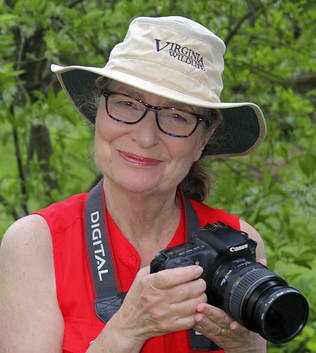 Marie Majarov, sporting her hat for sun protection! Photo by Milan Majarov.
Marie Majarov, sporting her hat for sun protection! Photo by Milan Majarov. --By Marie Majarov, VMN-Shenandoah Chapter
Editor's Note: The subject of this article is unusual for The Pollinator, but I wanted to include it because safety is such an important consideration for VMN volunteers. Marie is thoughtful in sharing her personal story so that her fellow VMN volunteers (and others) may learn from her experience. If other VMN volunteers have personal stories to share related to safety during VMN activities (e.g., experiences with tick-borne diseases, heat-related illnesses, etc.), please send them. I hope to make these safety stories a semi-regular feature. --MDP
As a naturalist with great respect for the sun and the natural world, an outdoor & nature photographer, a retired clinical psychologist with some medical savvy, and as a septuagenarian I had no idea! And neither have most people I’ve talked to since my recent, eye-opening experience with eyelid cancer.
I want you to know! As Virginia Master Naturalists I believe we need to be well informed as we are frequently out working, observing and serving in glorious sunshine. We also have a responsibility to set good examples with our self-care in the sun and to be able to educate those with whom we work.
I thought I had a sty on my left lower eyelid, no big deal. I used warm compresses, standard treatment, but in a few days when it did not go away -- actually it got quite a bit bigger, baby lima bean size and really irritating to my eye -- I went to see my eye doctor. “A chalazion” he said, a cyst-like nodule in or on the eyelid often developing after a sty or resulting from obstruction of an oil gland within the eyelid. “I’ll lance it, you will feel much better by tonight, and it should heal right up.”
Lancing however revealed no obstruction, inflammation, or infection; it was a hard growth, and not likely a standard chalazion. My doctor carefully removed a piece of it and sent it off to the lab and explained that there was a possibility that it could be cancer, skin cancer actually. “We’ll see what the lab report says, one step at a time…”
It was cancer, basal cell carcinoma. My doctor told my husband and me that he was not surprised, that he was fairly sure of a cancer diagnosis as soon as he cut into the growth, just not sure what kind. He was fearful it could be squamous cell carcinoma or worse, melanoma. I was lucky.
Four days after the diagnosis I was in the office of an outstanding ophthalmic plastic and reconstruction surgeon in northern Virginia. A whole new chapter of learning opened up before me. Surgery was scheduled for 10 days hence to remove the growth, and probably about a third of my eyelid with an inch of tissue below the lid aiming for clean margins, and followed by eyelid reconstruction.
This was MY EYE!!!! Eyes are so incredibly important to us all, and I am a photographer you know! Reading and having my surgeon explain and show me pictures of all that was involved in the hour and 45 minute procedure to be carried out so very close to my eyeball, both helped and made me even more anxious! The reconstruction pictures he showed me were amazing, but getting there made me apprehensive. To be honest, I was really a nervous wreck!
The surgery went beautifully and was not as onerous to me as the visions that swirled in my head leading up to it. The surgeon, with a pathologist present to evaluate the removed tissue, was able to get clean margins, the best of news to all cancer patients! Anesthesia today is amazing; and incredibly I had minimal pain afterwards! I had 48 hours of wet dressings, ointments on my raft of stitches for 2 weeks, and I had to keep my head upright even while sleeping, then just healing time….not bad at all. The results looked amazing from the beginning. It was hard to believe the surgeon had removed as much of my eyelid and tissue as he did and then was able to put things back together so smoothly. There will be little visible evidence of the surgery and most importantly my eye will work normally. Again, I was so very lucky!
My surgeon says that a “lifetime of sun” is the culprit here. I grew up in a generation where we were encouraged to get as much sunshine as possible. It was “good for us.” There was little known about skin cancer, sun screen products with SPF numbers were not available, and kids were not encouraged to wear sunglasses or hats. On many beach vacations I was quite sunburned and absorbed lots of sun glare from hours of enjoying the ocean and white sandy New Jersey beaches…for fair skinned people such as myself, a recipe for later problems. As a college student I worked summers as a lifeguard and swim instructor, wearing sunglasses…but I am not sure how good they were at that time. I am sure that it was a perfect situation for glare off the water to bounce up to my eye lids. I didn’t know, no one did, the problems that could lie ahead.
The Skin Cancer Foundation reports that “the eyelid region is one of the most common sites for nonmelanoma skin cancers. In fact, skin cancers of the eyelid, including basal cell carcinoma (BCC), squamous cell carcinoma (SCC), and melanoma, account for five to 10 percent of all skin cancers. Ninety five percent of these tumors are basal cell or squamous cell carcinomas.” Most being lower eyelid cancer. Absolutely staggering statistics, I had no idea!
Prompt treatment is crucial to good outcomes. While basal cell carcinomas do not spread/travel to other organs and therefore are not usually life threatening, they do spread in their area of origin. This is particularly tricky around the eyelid where the tissues are thin and if left untreated cancer cells can infiltrate to nearby vital ocular structures and even the perilously close brain.
One of the most common presenting symptoms for skin cancer on the eyelids is a growth like mine, which was likely growing under the surface for quite some time, years in fact. Other possible signals reported in the literature include: a change in appearance of the eyelid skin, swelling of the eyelid, thickening of the eyelid, chronic infection of the eyelid, or an ulceration (area where skin is broken) on the eyelid that does not heal.
Awareness that eyelid cancer and other skin cancer can happen to those of us exposed to much sunshine over our lifetimes is the first thing I want you to know. Next are the protective measures we can take and encourage others to take. Sunscreen is an important preventative measure in all skin cancer. So slather up exposed skin areas when you are in the sun…and don’t forget your ears a delicate area where basal cell carcinoma also takes a significant toll.
For the eyelid area however, slathering up with sunscreen is awkward to impossible because of the potential for rubbing it into and causing irritation to the delicate eye. Sunglasses must be your sunblock. Wear sunglass that block 99-100% of ultraviolet light. This is essential! Also broad brim hats that have a darker underside to the brim help greatly to decrease glare to your cheeks and eye area. The brim should surround the hat; baseball hats are not as useful because they allow for glare exposure from the side, and as to other skin cancers they leave ears and neck exposed.
I have long worn a great UV+45 kaki colored Virginia Wildlifehat (a present from the editor) with a perfect brim, underside forest green. My sunglasses however often get tossed aside or tangled as I struggle with straps around my neck for my camera, a lens viewer, binoculars, glasses etc. while I photograph and observe nature. No longer will this happen; when healed all the way there is a large style pair of prescription transition glasses in my future. In fact I take this so seriously I am even considering wearing black under my eyes like a football player when I garden or am out on the water!
Make no mistake, this is very serious. Eyes are precious! I am indeed very fortunate that my cancer was diagnosed and treated quickly once it became visible. I want you to know, to be aware, and take precautions. ….and please educate others.
References and Resources:
https://www.cancer.net/cancer-types/eyelid-cancer/overview
https://eyecancer.com/eye-cancer/conditions/eyelid-tumors/basal-cell-carcinoma-eyelid-cancer/
https://www.skincancer.org/prevention/sun-protection/for-your-eyes/the-eyelids-highly-susceptible-to-skin-cancer
Marie Majarov ([email protected]) is a Shenandoah Chapter Virginia Master Naturalist and photojournalist whose work is frequently featured in Virginia Wildlife Magazine.


 RSS Feed
RSS Feed